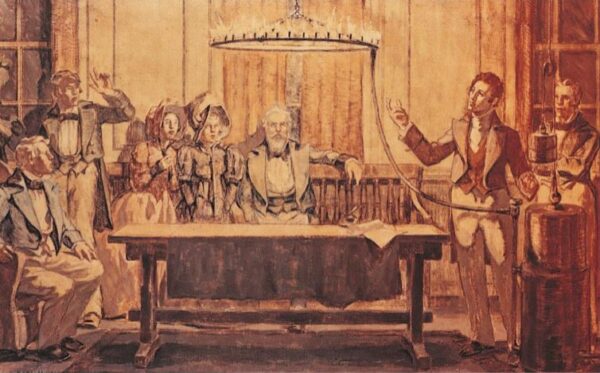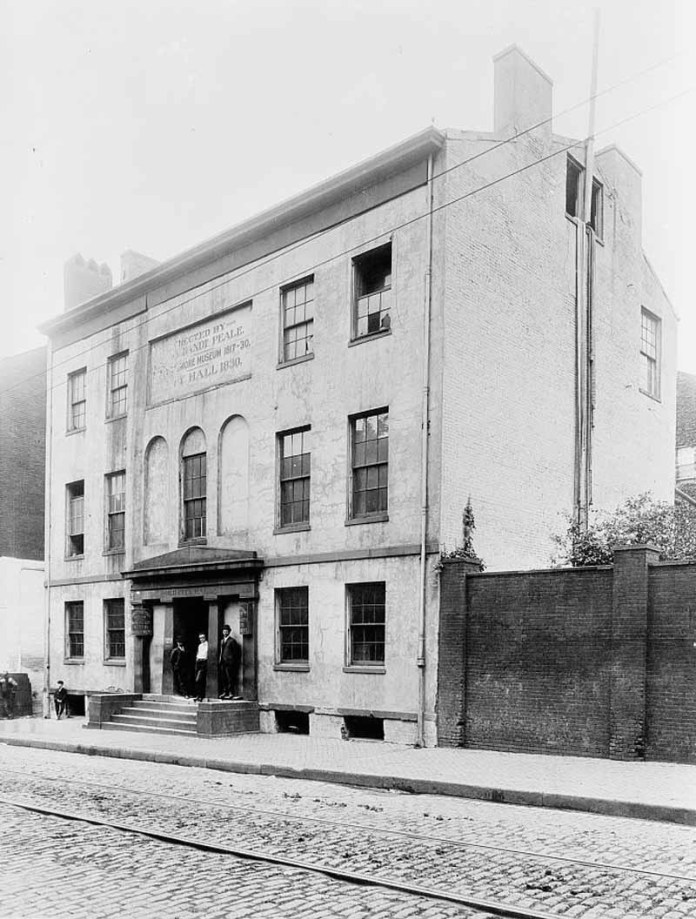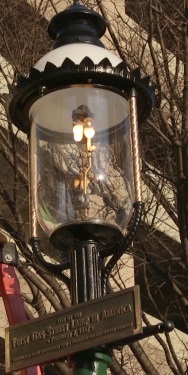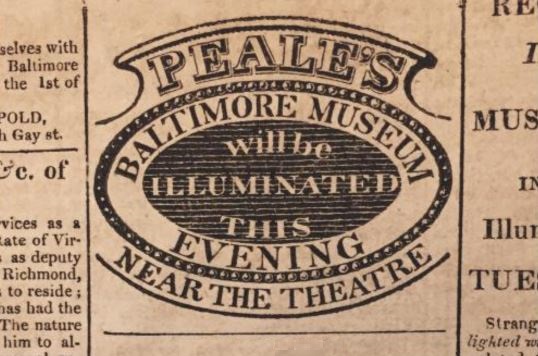Gas lamps illuminated Baltimore streets in 1817 after a dazzling demonstration at an art museum.
America’s first public street lamp (fueled by manufactured gas) illuminated Market Street in Baltimore, Maryland, on February 7, 1817, making the Gas Light Company of Baltimore the first U.S. commercial gas lighting company. A replica of the original street lamp, which burned gas distilled from tar and wood, was erected there a century later.
A small, brass monument to the company and its street lamp stands at the corner of North Holliday Street and East Baltimore Street (once Market and Lemon streets). Dedicated by the city’s utility company in 1991 and fueled by natural gas, the elegant lamp is a 175th-anniversary replica of the original 1817 design.
In 1816, well-known artist, inventor, and museum founder Rembrandt Peale made headlines by illuminating with artificial gas a large room in his Holliday Street museum, which featured artworks and natural history exhibits. This first demonstration dazzled civic leaders, leading businessmen, and socialites gathered there.

Before he established America’s first gas utility in 1817, artist Rembrandt Peale hosted a demonstration of manufactured gas-fueled “Gems of Light” in his Baltimore museum. Photo courtesy BG&E.
“Taking after a natural history museum that his father, Charles Wilson Peale, started in Philadelphia in 1786, Rembrandt Peale displayed collections of fossils and other specimens, as well as portraits of many of the country’s founding fathers that his family had painted,” noted a historian for Explore Baltimore Heritage. Peale hoped his demonstration would attract investors like moths to a flame.
“During a candlelit period in American history the forward-thinking Peale aimed to form a business around his gas light innovations, the exhibition targeting potential investors,” added another historian at the utility Baltimore Gas & Electric.
“Gems of Light”
Rembrandt Peale’s manufactured gas gamble in 1816 worked. Onlookers were awed by his museum display of “a ring beset with gems of light.”
Several of the city’s financiers approached Peale to form the Gas Light Company of Baltimore, BG&E’s precursor. Less than a year later, on February 7, 1817, America’s first public gas street lamp was lit in a ceremony one block south of City Hall.
An impressed city council approved Peale’s plan to light more of the city’s streets. BG&E also credits Baltimore inventor Samuel Hill for establishing America’s first gas meter manufacturing company in 1832. Two years later the first meters were installed. The rapidly growing company petitioned the city to begin laying underground pipelines in 1851.

“Peale’s Baltimore Museum and Gallery of Paintings” opened in 1814 in a building designed by architect Robert Carey Long. Photo courtesy Baltimore Heritage.
Over the coming decades, two miles of gas main would be completed under Baltimore streets and the company showed its first profit. Metering replaced flat-rate billing, helping residents afford to light their homes using pipelines from gasworks.
By 1855, a new gas manufacturing plant was constructed to distill gas from coal — a great improvement over the former “gasification” of tar or wood. Manufacturing gas from coal had earlier proved successful in Philadelphia.
Following the illumination of Baltimore, public use of manufactured coal gas began brightening New York City streets in 1823, after the New York Gas Company received a charter from the state legislature to light parts of Manhattan.
Consolidated Edison Inc. was established in November 1884 by the merging of six gaslight competitors: New York, Manhattan, Metropolitan, Municipal, Knickerbocker and Harlem gas companies; learn more in History of Con Edison.
Coal Gas lights Philadelphia
Forty-six lights burning manufactured “coal gas” were lit on February 8, 1836, along Philadelphia’s Second Street by employees of the newly formed Philadelphia Gas Works. As Philadelphia became the nation’s center for finance and industry, the municipally owned gas distribution company began a series of gas-manufacturing innovations.
By 1856, Philadelphia Gas completed construction of a gas tank at the company’s plant on the east side of the Schuylkill River at Point Breeze.

A manufactured gas storage facility at Point Breeze in South Philadelphia, circa 1856. Photograph courtesy Philadelphia Gas Works.
“Demand for gas grew, and the city constructed a second gas manufacturing plant on the east side of the Schuylkill River at Point Breeze,” noted the Pennsylvania Magazine of History and Biography (October 2015 ). “Like the original gas works, the site at Point Breeze was chosen to facilitate deliveries of coal by ship or barge.”
The Point Breeze gas plant was the largest in the nation with a holding capacity of 1.8 million cubic feet. As demand for kerosene lamp fuel grew in the late 1860s, Atlantic Refining Company constructed a refinery south of the Philadelphia Gas Works’ Point Breeze facility for shipping products to domestic and foreign markets (also see America exports Oil).
Gasification Plants
When the American Centennial Exposition of 1876 displayed the wonders of the age in agriculture, horticulture and machinery, gas cooking was showcased as a novelty. Sixty miles of pipe brought manufactured gas to the exhibition’s lamps.
California’s San Francisco Gas Company was incorporated on August 31, 1850, by Irish immigrants Peter and James Donahue and engineer Joseph Eastland. After erecting a coal gasification plant, their company illuminated the first San Francisco “town gas” street lamps in 1852.
After decades of mergers, the company became Pacific Gas & Electric (PG&E) in 1905.
In Illinois, the Chicago Gas Light & Coke Company delivered its first gasified coal on September 4, 1850.
“The gas pipes were filled, and the humming noise made by the escaping gas at the tops of the lamp-posts indicated that everything was all right,” according to The Gem of the Prairie.
“Shortly afterward the fire was applied and brilliant torches flamed on both sides of Lake Street as far as the eye could see and wherever the posts were set,” the publication added.
Washington Gas Light
Four days after the laying of the cornerstone of the Washington Monument, an Act of Congress on July 8, 1848, established the Washington Gas Light Company, which installed manufactured gas lights in the House and Senate chambers, the White House, and along Pennsylvania Avenue.
Manufactured gas distilled in a nearby plant flowed through newly installed pipes into light fixtures throughout the Capitol.
Washington Gas Light would construct giant tanks (gasometers) on 6.5 acres of gasworks in the D.C. neighborhood of Foggy Bottom.
Transitioning from manufactured gas by 1931, the utility company introduced natural gas to the capital area when President Herbert Hoover opened a pipeline valve and started the flow from natural gas fields in Kentucky and West Virginia. With more than 1.2 million customers in 2023, Washington Gas celebrated its 175th anniversary.
Coal Gas Museums
Gas manufactured from coal helped illuminate the United Kingdom’s industrial revolution. A British museum today preserves perhaps the world’s largest collection of artifacts relating to the manufactured gas industry, and how coal gas light and heat changed society.
According to the National Gas Museum, which opened in 1977 in Leicester, England, many people discovered that heated coal produced a brightly burning gas, but it was Scottish engineer William Murdoch, “who first put this to practical use, lighting his house in Cornwall with it in 1792.”
Birmingham steam engine manufacturers Boulton and Watt, Murdoch’s employers, began constructing gas works for factories. The National Gas Museum’s exhibits, housed in the former gatehouse of a gasworks plant, include washing machines, gas irons, and a gas-powered radio. Many rare items are from the London Gas Museum, which closed in 1998.

The Dunedin Gasworks Museum in New Zealand is one of three known preserved gasworks museums in the world. The manufactured gas plant operated from 1863 until 1987. Photo courtesy Dunedin Gasworks Museum.
Coal gas supplies and pipelines in the United Kingdom converted to natural gas by the 1970s. Manufactured gas energy history is also preserved in New Zealand’s Dunedin Gasworks Museum and the Warsaw Gas Museum in Poland.
Natural Gas Street Light
According to most historians, the earliest commercial use of natural gas (not manufactured gas) took place in Fredonia, New York, decades before the 1859 first U.S. oil well in Pennsylvania. Natural gas was piped to downtown Fredonia stores, shops, and a mill from a natural gas well drilled in 1825 by William Hart.
Hart drilled several wells before producing commercial amounts of natural gas. “He left a broken drill in one shallow hole and abandoned a second site at a depth of forty feet because of the small volume of gas found,” noted historian Lois Barris in her history of the Fredonia Gas Light and Water Works Company.
“In his third attempt, Mr. Hart found a good flow of gas at seventy feet,” she explained. “He then constructed a crude gasometer, covering it with a rough shed and proceeded to pipe and market the first natural gas sold in this country.”
Hart’s early customers annually paid $1.50 for each light, and one natural gas light, “was claimed to yield the light of two good candles. The owner of a mill, on whose land the well was drilled, received two free gas lights for his office as royalty,” noted Barris, citing the 1949 book Empire Oil: The Story of Oil in New York State.
Located between Buffalo and Erie, New York’s Fredonia Gas Light and Water Works, incorporated as America’s first natural gas company, on April 14, 1857. Hart would later be called the father of the U.S. natural gas Industry.
Learn more about the early natural gas industry in Natural Gas is King in Pittsburgh and Indiana Natural Gas Boom — and a 1903 natural gas well drilled in Dexter, Kansas. The latter led to a university professor’s discovery that natural gas could produce commercial volumes of Helium (see the Kansas “Wind Gas” Well).
Electric Arc Street Light
America’s transition to electric street lighting began on April 19, 1879, when Charles Brush of Cleveland, Ohio, demonstrated his “dynamo arc light” using 12 electric arc lamps to illuminate Monument Park for thousands of spectators, many wearing smoked glasses.
Brush knew he was demonstrating “a product that could potentially replace gas lamps as street illumination by arcing carbon electrodes that would produce a glow equal to 4,000 candles in a single lamp,” noted a 2017 article in Cleveland Magazine.
“A decade after lighting Public Square and transforming cities throughout the world, Brush sold his company in 1889 to the Thomson Houston Co., which in 1892 merged with Edison General Electric to form General Electric,” reported the article, Cleveland was the First City of Light.
_______________________
Recommended Reading: In Pursuit of Fame: Rembrandt Peale, 1778-1860 (1993); The Extraction State, A History of Natural Gas in America (2021); Helium, Its Creation, History, Production, Properties and Uses (2022); Empire Oil: The Story of Oil in New York State(1949). Your Amazon purchase benefits the American Oil & Gas Historical Society. As an Amazon Associate, AOGHS earns a commission from qualifying purchases.
_______________________
The American Oil & Gas Historical Society (AOGHS) preserves U.S. petroleum history. Please become an AOGHS annual supporter and help maintain this energy education website and expand historical research. For more information, contact bawells@aoghs.org. Copyright © 2025 Bruce A. Wells. All rights reserved.
Citation Information – Article Title: “Illuminating Gaslight.” Authors: B.A. Wells and K.L. Wells. Website Name: American Oil & Gas Historical Society. URL: https://aoghs.org/technology/manufactured-gas. Last Updated: June 5, 2025. Original Published Date: January 30, 2016.






